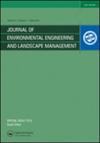稻壳对工业废水中cu (ii)离子的生物吸附:实验、统计和Ann模型
IF 1.1
4区 环境科学与生态学
Q4 ENVIRONMENTAL SCIENCES
Journal of Environmental Engineering and Landscape Management
Pub Date : 2021-12-14
DOI:10.3846/jeelm.2021.14386
引用次数: 4
摘要
废水中重金属的去除是一个重要的研究领域,需要可持续发展。重金属对健康造成有害影响,增加环境毒性。吸附法是一种非常有效的重金属去除方法。报道了一种利用农业废弃物稻糠脱除Cu(II)的固定床。研究了pH为6时不同操作变量(进水浓度(10-30 mg/L)、流速(10-40 ml/min)和床层高度(4-10 cm)下的突破曲线。考察了进水浓度、流速、床层高度等工艺参数的变化规律。实验数据表明,吸附量随进水浓度的升高而增大。在流速为10 ml/min、床高为4 cm、进水浓度为30 mg/L时,吸附量最大值为10.93 mg/g。也成功地实现了MLR和ANN建模的适用性。ANN具有比MLR更好的可预测性。研究结果表明,稻壳可用于处理含铜工业废水。本文章由计算机程序翻译,如有差异,请以英文原文为准。
BIOSORPTION OF CU(II) IONS FROM INDUSTRIAL EFFLUENTS BY RICE HUSK: EXPERIMENT, STATISTICAL, AND ANN MODELING
Heavy metal removal from wastewater is a significant research area and recommends sustainable development. The heavy metals cause harmful health effects, increase environmental toxicity. Adsorption is a very effective method for heavy metal removal. A fixed bed for Cu(II) removal using rice hush, an agricultural waste, is reported in this paper. The study was carried out to determine the breakthrough curves with varying operating variables like influent concentration (10–30 mg/L), flow rate (10–40 ml/min), and bed height (4–10 cm) at pH 6. The variation of the process variables like influent concentration, flow rate, and bed height were investigated. The experimental data shows that adsorption capacity increases with the rise of influent concentration. The maximum value of adsorption capacity is 10.93 mg/g at a flow rate of 10 ml/min, bed height 4 cm, and influent concentration 30 mg/L. The applicability of the MLR and ANN modeling has also been successfully carried out. ANN has better predictability than MLR. The findings revealed that rice husk could be used to treat copper-containing industrial effluents.
求助全文
通过发布文献求助,成功后即可免费获取论文全文。
去求助
来源期刊
CiteScore
1.90
自引率
7.70%
发文量
41
审稿时长
>12 weeks
期刊介绍:
The Journal of Environmental Engineering and Landscape Management publishes original research about the environment with emphasis on sustainability.

 求助内容:
求助内容: 应助结果提醒方式:
应助结果提醒方式:


